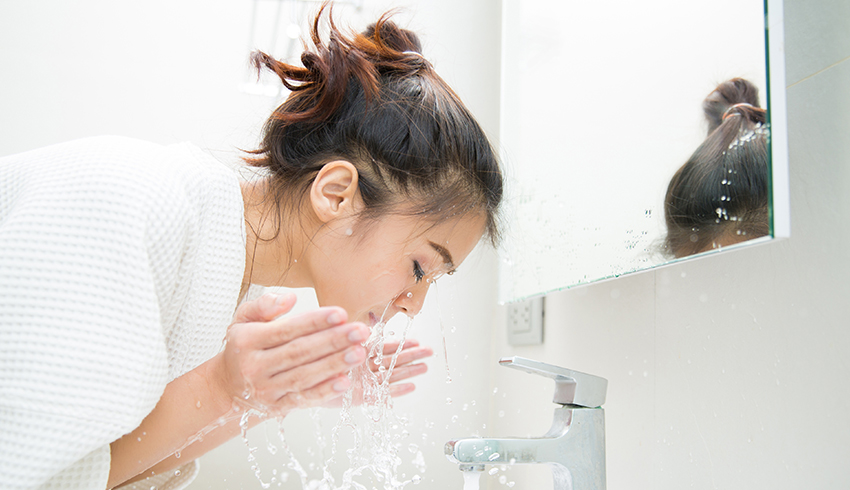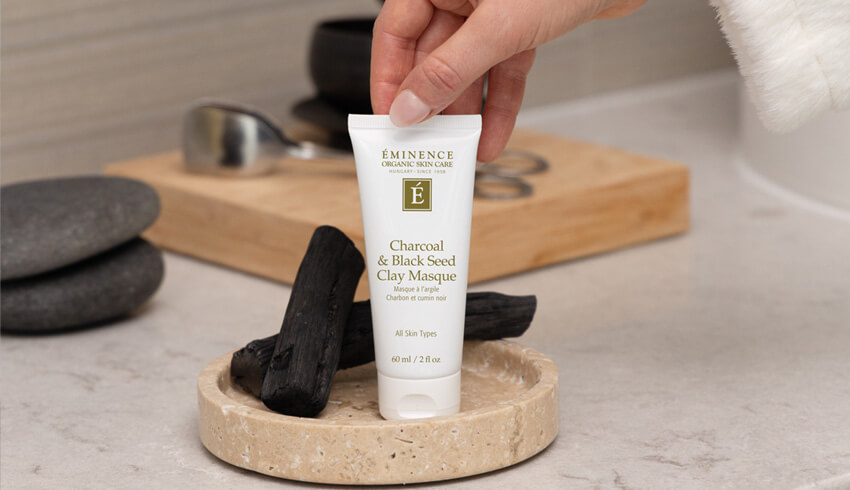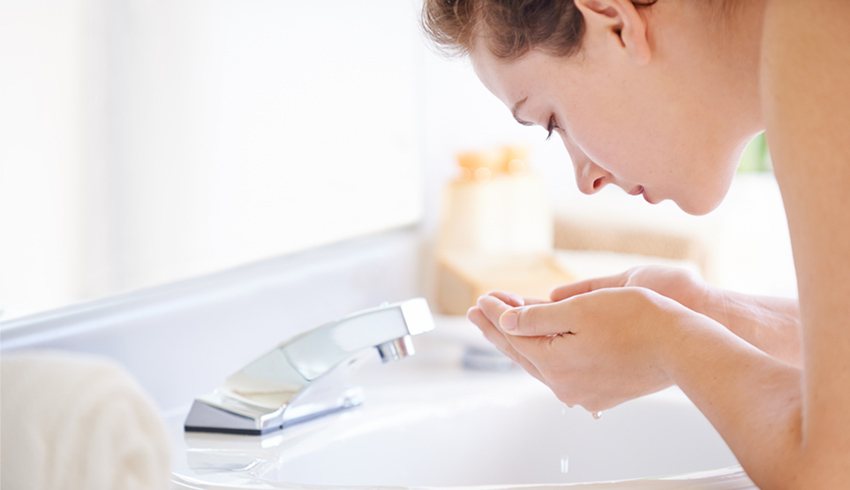
Washing your face may seem simple, but are you doing it properly? A thorough cleanse can make all the difference in the effectiveness of your routine, yet most of us don’t give this step the time and attention it deserves. Cleansing your skin comes down to more than a quick rinse with your favorite face wash. From which cleanser to choose to how often to wash your face, here’s our guide to getting the most out of your cleansing step.
Dos & Don’ts for Washing Your Face
Sure, washing your face sounds simple but it’s all in your technique. As the American Academy Of Dermatology Association says, “How you wash your face can make a difference in your appearance.” Proper facial cleansing not only improves skin health, it also encourages efficient skin cell turnover, minimizes the likelihood of breakouts and can even reduce the look of inflammation. Here are tips from the Eminence Organics Product Support Team for how to cleanse your face effectively.
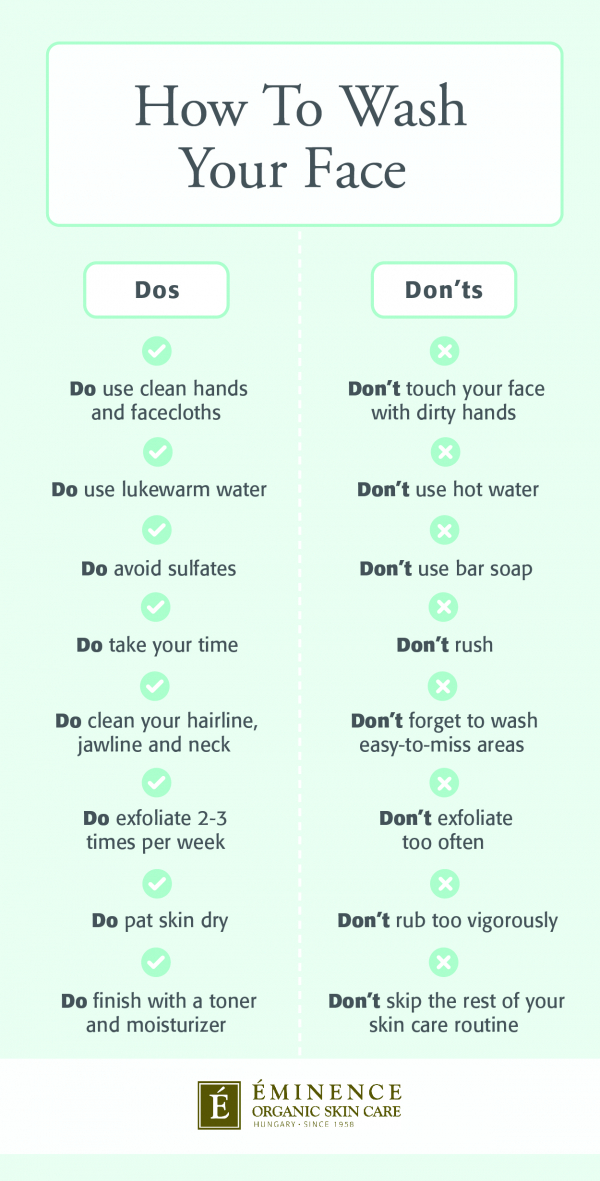
Wash Your Hands First
Rule number one: Wash your hands before washing your face. It may sound like a no-brainer, but a surprising number of people skip this important step, transferring the bacteria from their hands to their faces. From doorknobs to our keyboards and cell phones, bacteria is everywhere. According to the University of Colorado, we carry a shocking number of bacteria on our hands: 3200 from 150 different species. Ensuring that you have clean hands (and clean face cloths) is the first step for an effective cleansing process.
Test Your Water Temperature
Once you’ve given your hands a thorough clean, ensure you use the right water temperature. Not to echo Goldilocks (but we will), you don’t want to use water that is too hot or too cold. Exposing the skin to different extremes can cause irritation, dryness and strip your skin of its protective layer. So, what temperature is just right? Lukewarm water is the perfect temperature to clean your skin and keep it protected.
Avoid Sulfates
Just like extreme temperatures, chemical additives like sulfates can strip your skin of its protective layer, causing irritation, dryness and discomfort. These surfactants may produce a satisfying lather and cut oil from the skin, but they are much too strong and can damage and dehydrate your complexion over time. As a general rule, if you see sodium lauryl sulfate, ammonium lauryl sulfate, sodium laureth sulfate or ammonium laureth sulfate on your cleanser’s ingredient list, it’s time to swap it out for a natural alternative.
Take Your Time
Another rule of thumb: Don’t over (or under) scrub your skin. Over-washing can lead to dryness and irritation, while under-washing can lead to buildup and breakouts. The goal is to hit a happy medium. Most beauty experts advise a 20 to 30 second cleanse morning and night to keep your skin clean and refreshed.
Extend Past Your Chin
It’s easy to miss your jawline and neck during your daily cleanse, but these areas also collect dirt and debris. When you apply your cleanser, be sure to extend it past your chin. Using circular motions, gently work your way up from your neck to your jawline. This massaging motion will not only clean the area but also activate blood and lymph circulation, reducing puffiness and giving you a healthy-looking glow.
Exfoliate Regularly
In addition to washing your face, you’ll want to boost your cleansing routine a few times a week by exfoliating. Regular exfoliation encourages healthy skin cell turnover, removes dead skin cells and clears buildup that can lead to clogged pores and breakouts. That said, don’t reach for an abrasive option that can cause microtears and inflammation. Instead, we recommend adding a couple of shakes of Strawberry Rhubarb Dermafoliant to your favorite Eminence Organics cleanser or choosing a two-in-one option like our Mangosteen Daily Resurfacing Cleanser.
Product Picks
Use A Clean Washcloth
Once you’ve washed your face, don’t undo your cleanse by reaching for a dirty washcloth or towel. Moist washcloths harbor all sorts of microscopic critters — and using the same one over and over can spread bacteria, germs and mold to your face. Likewise, don’t dry your face and body with the same towel. Keep things separate to avoid transferring pore-clogging residue from your shower products to your complexion.
Pat Dry
When you’re ready to dry your face, be gentle. Alicia reminds us that the skin is delicate: “Make sure you don’t rub your face vigorously when you’re drying off.” Rubbing aggressively can cause irritation and gradually reduce elasticity in your skin. Instead, gently pat skin dry with a clean towel. Remember: Your skin doesn’t have to be bone-dry — leaving a bit of moisture will actually help subsequent products absorb better.
Finish With A Toner
Skipping toner in your skin care routine is like washing your hair with shampoo and forgetting to use conditioner. Toning completes the cleansing process: It removes lingering impurities and replenishes the skin with necessary hydration and moisture.
How Often Should You Wash Your Face?
Now that you know the ins and outs of cleansing, how often should you wash your face? Experts agree that even if you’re not wearing makeup, it’s important to wash your face morning and night. Rachel Nazarian MD tells SELF: “While you're tossing and turning at night, bacteria from your saliva and oils from your hair are easily transferred to your face and eyes.” Even a quick rinse in the morning is better than not cleansing at all. Washing your face at night helps to remove makeup as well as any impurities that have settled on your skin’s surface and seeped into your pores throughout the day. It also leaves your skin with a clean slate that can better absorb the active ingredients in your night care products.
What Happens If You Don’t Wash Your Face
Need more persuasion on the importance of face washing? Cast your mind back to the “caveman regimen”, the short-lived fad which involved washing your face like a caveman, i.e., not at all. Quickly debunked by dermatologists, it’s no surprise that an anti-washing skin care routine causes a host of skin problems. For all skin types, the failure to remove impurities on a regular basis means that makeup residue, oil, sweat, microbes and dead skin cells stay on your skin. This buildup can clog pores, cause dullness and contribute to breakouts.
Which Cleanser Is Right For You?
Once you’ve committed to keeping your complexion clean, you’ll want to explore the right cleanser for you. Just as you choose serums, oils and concentrates that are suited to your skin type and concerns, the same goes for your cleanser. Here is a breakdown of the different types of cleansers you can choose for your complexion.
Cleansing Oils & Balms
Cleansing oils and balms are suitable for all skin types (even oily!). They lift away impurities and excess oil, remove makeup and keep the skin’s moisture barrier in tact. To use, simply warm an oil cleanser or balm in your hands, then apply to the skin using circular motions and rinse. If you are using a double cleansing method, you can follow with any other type of cleanser to wash away the last traces of dirt and debris.
Gel Cleansers
Versatile gel cleansers leave the skin feeling clean, clear and smooth. These are the perfect pick for those with a combination or oily complexion who want to remove oil but don’t want to leave their skin stripped. If you prefer a lightweight, hydrating cleanser that won’t leave your skin feeling dry or tight, this is the one for you.
Foam Cleansers
Foam cleansers are fantastic for oily and acne-prone skin, but be careful to avoid sulfates. Traditional foaming cleansers can be harsh, so opt for a version that contains gentle, plant-derived foaming agents. These will give your skin a deep clean and still leave skin soft and smooth.
Exfoliating Cleansers
Exfoliating cleansers are an easy way to double-up steps in your skin care routine by cleansing and exfoliating in one. These can provide physical exfoliation (from natural ingredients like finely ground olive seed) and/or chemical exfoliation (with alpha hydroxy and beta hydroxy acids) and are gentle enough to use daily.
Cream Cleansers
Do you have dry or sensitive skin? The best choice for you is a cream cleanser that hydrates and moisturizes skin while gently washing away impurities. After massaging a small amount into your skin and rinsing away, it will feel perfectly cleansed and replenished.
How To Wash Your Face
As mentioned, an effective cleanse comes down to technique. Here are the exact steps to follow to wash your face properly:
- Wash your hands.
- Dispense ½ a pump or squeeze of cleanser into your palm.
- Add a small amount of water to emulsify the product (for cleansing oils and balms, this step is optional).
- If you are using an oil cleanser or balm, warm the product between your hands.
- Using your fingertips, gently massage the cleanser into your skin using small, circular motions.
- Rinse with lukewarm water.
- Pat dry.
- Follow up with your favorite toner.
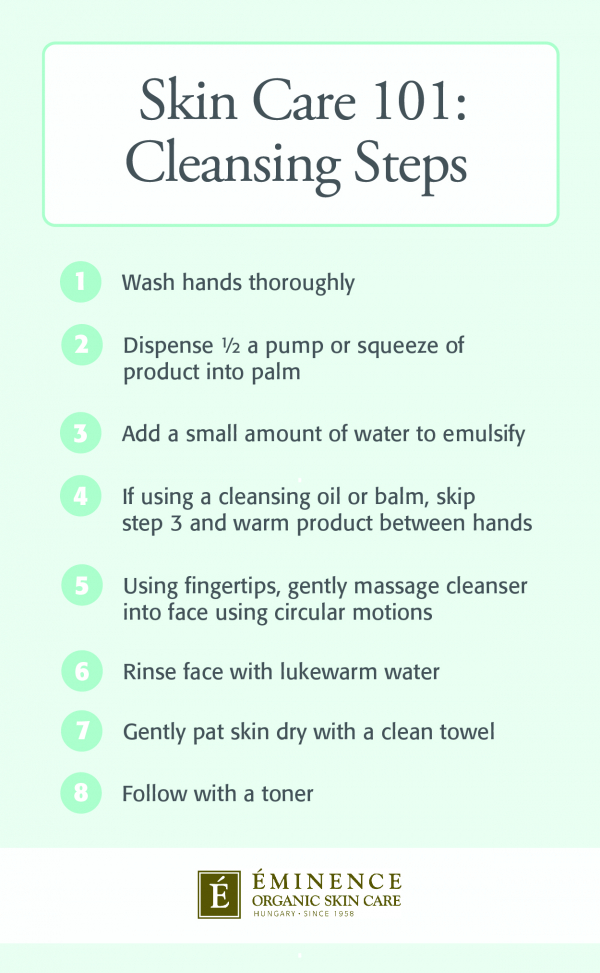
Do you have any questions about how to wash your face? Ask them in the comments below or get in touch with an Eminence Organics Spa Partner to chat with a licensed esthetician.



